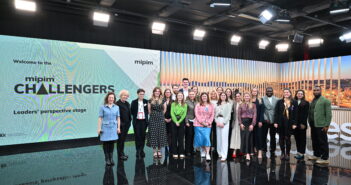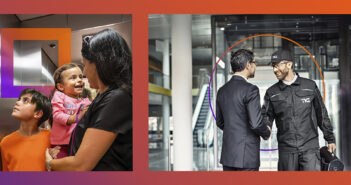By: Cormac Crossan, Business Development Director, Real Estate at Schneider Electric
I was honoured to speak about reimagining the future of the workplace at last month’s Propel by MIPIM Paris event where top real estate leaders from around the region gathered, both physically and virtually. Attendees – all masked I hasten to add! – were cautiously optimistic about the future yet realistically planning for the potential of a long road ahead. Taking into account the impacts of the pandemic and ongoing competition for top occupiers, the global commercial real estate market is arguably facing greater challenges than it has ever seen before. This was evident in the questions and answers during the sessions at the event. My co-panelist Gilles Betthaeuser from Colliers encapsulated the challenge neatly in one word: “sustain-agility” – the necessary approach to sustain growth, tackle climate change and nonetheless remain agile in the face of the current crisis.
It is clear that developers, investors, and landlords will increasingly need to use a combination of strategies to differentiate their portfolios and the assets within them. This includes creating healthier and more efficient buildings, while offering more occupant services, and enabling remote building operations. Connected, smart building technologies are clearly one way to do all of this.
According to a study by the World Economic Forum Digital Transformation Initiative, “every $1 invested in combined new digital technologies yields a 120% increase in revenue per employee.” As succinctly stated by Nicolas Kozubek, Director of Propel by MIPIM, “if technology can help in any way to create more sustainability as well as convenience and wellbeing in a commercial building, then it’s a must-have.”
To support the transition from low to full or partial occupancy (and potentially back again), connected technologies can address the following four key areas of action:
Download the exclusive white paper now. >>>
1. Occupant Well-Being
With the need to reopen buildings safely, occupant well-being and productivity can be improved through better and more autonomous control of the indoor environment. If things like air quality and temperature were bones of contention before, those preoccupations will be magnified by the current situation. Digitization of building systems enables continuous collection of sensor data. Cloud-based applications can monitor health and comfort-related conditions across every zone of the building, including airflow, temperature, fresh air, humidity and air quality. If poor air circulation or changes in parameters like humidity are detected, the building management system can automatically respond and make immediate adjustments as necessary.
Tracking occupancy and under-desk sensor data helps in directing cleaning teams to focus on areas that have been used. This supports a healthy building, as well as improving efficiency.
2. Space Management
How space is used will undeniably change in the current climate. In this period of flux, getting a grasp of what the real data looks like will be invaluable. The days of clipboard audits are giving way to a new age of technology. Occupancy sensors and space management tools can measure people-counts in different areas in real-time. We’ve been hearing about the internet of things for many years, but the current crisis is very likely to accelerate its democratization in the built environment. With the latest sensor technology and software you can set capacity thresholds so an alarm is sounded when occupancy for a room, floor, or building exceeds recommended limits. Continuously monitoring occupancy levels will also ensure occupants are following distancing guidelines. Adapting interim policies for usage of common areas – such as the cafeteria, gym, and break-out areas – can be driven by collected data on usage patterns.
To help establish a smart workplace, software can be used to identify new occupancy patterns, underutilized desks, meeting rooms, etc. so that resources can be reallocated or office layout adapted as necessary. Employees can also be given app-based access to see available spaces in real-time to support office hoteling.
3. Occupant Engagement
If you’re like me, you may have been frustrated in the past that you didn’t have all of the information about your building at your fingerprints. “Where is that meeting room?” “What’s on the lunch menu today?” “The carpark is full again!” One silver lining in 2020 may be making that sentiment very much a thing of the past. The newest occupant engagement apps give owners and operators a direct line of communication to an individual’s mobile device. The entire workforce can be kept informed on latest company updates and workspace usage or changes, while employees can be selectively notified based on roles or teams in the organization. This same app can deliver a view of occupancy levels and available ‘safe’ spaces, helping ease navigation to get people to where they need to go faster, while avoiding areas that may currently be over-occupied, such as crowded lobbies with queues of people waiting for lifts.
These new platforms also give occupants access to digital tools that let them control their own thermostats, lighting, access control, and parking preferences. They can also reserve a meeting room or stay connected to community events. Offering occupants this kind of app-based experience can be a competitive differentiator for building stakeholders.
4. Operational Efficiency
While people-safety is a top priority, it’s also important to maintain building and operational efficiency. A digital infrastructure that integrates power and building management, along with cloud-enabled advisory services, will help facility teams make better decisions, improve equipment performance, and do more with often limited on-site resources. For example, by monitoring occupancy levels, setpoints for HVAC can be adjusted where needed to reduce energy consumption, while airflow, pressure, temperature, and humidity are monitored to maintain a healthy work environment.
Remote operations are now here to stay too. We’ve been hearing for years now that condition-based maintenance can yield massive savings on overall operational expenditure. Thanks to connectivity, the majority of a building’s operations can be performed remotely, allowing for preparedness regardless of on-site presence. Using remote monitoring, fault detection, and ‘digital twin’ technology, the number of site visits can be reduced, with root cause analysis and remote control helping fix about 80% of problems. If a site visit is required, time there will be reduced, as the technician will already know what equipment requires attention, its cause of failure, and the actions to take to quickly resolve the issue.
Furthermore, a building that is resilient in the face of risks will operate reliably and safely without interruption. Connected building technologies and services help protect building occupants from electrical fire risks while safeguarding facility teams during operation and maintenance. Expert advisors can help identify equipment issues before they become problems, minimizing potential disruptions while enabling a predictive maintenance approach that saves time and costs.
Ultimately, the newest connected building technologies and advisory services give building owners and operators a unique opportunity to meet the challenges of today and tomorrow by ensuring occupant well-being, dynamically managing building space, creating a more engaging experience, and delivering greater operational efficiency. The sum of these strengths are the basis of a powerful differentiator in the real estate market.
As a global sponsor of the Propel by MIPIM events, Schneider Electric is pleased to see MIPIM tackling the ‘new normal’ with increased integration of digital into their events. This aligns with the acceleration to digitization we are seeing in our own customers’ sites. Read the strategy paper, produced in collaboration by Sncheider Electric and Propel by MIPIM, to discover more details on this topic. To learn more about connected products you can use to help restart, efficiently operate, and future-proof your buildings, visit EcoStruxure™ for Commercial Real Estate.
Download the exclusive white paper now. >>>



